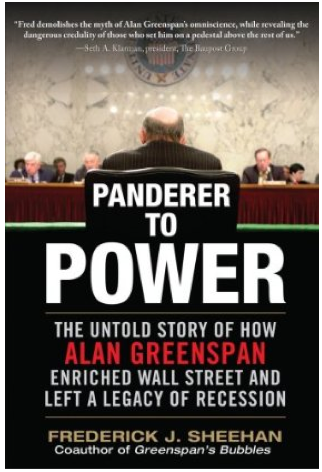 Frederick Sheehan is the co-author of Greenspan’s Bubbles: The Age of Ignorance at the Federal Reserve.
Frederick Sheehan is the co-author of Greenspan’s Bubbles: The Age of Ignorance at the Federal Reserve.
His new book, Panderer for Power: The True Story of How Alan Greenspan Enriched Wall Street and Left a Legacy of Recession, was published by McGraw-Hill in November 2009. He was Director of Asset Allocation Services at John Hancock Financial Services in Boston. In this capacity, he set investment policy and asset allocation for institutional pension plans.
~~~
The world is undercollateralized. This is the single most important feature of the 2011 economy. Sixty years ago, if assets were worth less than loans, it was possible to work our way into the black. In 1950, 59% of U.S. corporate profits were from manufacturing; 9% were from finance. The roles of manufacturing and finance have reversed. Thus, we witness the desperate attempts to forestall what cannot be prevented. Yet, the world must deleverage. Banks must write off loans. Loans to bankrupt developers and companies must be called. Living standards must fall.
The authorities are doing all they can to prevent the necessary deleveraging. That is the context in which Michael A.J. Farrell, CEO of Annaly Capital Management (NLY- NYSE), spoke to investors during his company’s first quarter 2011 conference call:
“[T]he change that is happening in the financial markets is a chaotic mess. I believe the simultaneous execution of radical monetary policy, fiscal policy, and financial regulatory reform is introducing rather than reducing systemic risk in the global financial system by ignoring the simplest lesson of the scientific method. Rather than change one variable in a complex system and test the outcome, regulators and policymakers are changing virtually all of them at the same time: QRM [quantitative risk management], risk retention, the Volcker Rule, Basel III capital rules, derivatives clearing and related margin requirements. GSE reform. FAS 166 and 167. Zero-bound fed funds policy and QE2. Deficit financing, structural budgetary imbalances, and debt limit debate.”
Where will this end? Michael Lewitt, proprietor of Harch Capital Management in Boca Raton, Florida, discussed the consequences of our leaders’ catastrophic policies in the May issue of his monthly letter, The Credit Strategist:
“Rather than confronting sources of volatility, policymakers have sought to smooth out volatility at all costs. Unfortunately, these costs are proving to be very high and will ultimately prove prohibitive. Pressures build inside complex systems until they can no longer be suppressed. When these pressures can no longer be contained, they tend to erupt with far greater violence than had they been allowed to adjust earlier.
Lewitt continued. Federal Reserve Chairman Greenspan and Bernanke “convinced investors the Fed would bail them out if the economy or markets got into serious trouble. As a result, investors engaged in increasingly reckless behavior…” The result: “Rather than saving the markets, Mr. Greenspan’s philosophy and approach guaranteed their failure.” One of the consequences is “the build-up of unsustainable debt levels.”
We are overleveraged, undercollateralized, and accentuating these unsustainable imbalances. Lewitt notes, “the Federal Reserve has accounted for 101 percent of the net Treasury bond issuance during the first four months of 2011.” He goes on: “The U.S. government has been the largest purchaser of Treasuries, promulgating a Ponzi scheme of unprecedented scale.”
The U.S. Treasury issues debt and QE2 buys it. Lewitt notes that 10-year Treasury yields have fallen from 3.59% on April, 11 2011, to 3.15% on May 6, 2011.
Since the Fed is the sole net buyer, the 10-year-yield is not a real interest rate. (It has not been a true market for years, but never more so than now.) This is also true of the zero-percent short-term yield, one of the trial balloons listed by Michael Farrell. Interest rates are integral to the pricing of assets. A country without an interest rate has a stock market with a price, but not a value.
The future-focused investor should estimate the value of stocks, commodities, and bonds as if interest rates were 5% higher. That day will come to pass: when assets seek the price of their true collateral. This is not widely appreciated. For instance, the recent dive in silver prices has been acclaimed as a bubble that popped. That might be true, if paper contracts were worth the value they purport to represent. There is not enough silver in the world to meet derivative claims – of ETFs, forward contracts, and so on. When this misrepresentation is widely recognized, physical silver will attract panic buying.
Silver is a fairly small market, so this may go unnoticed. That will be a shame for the majority since everyone holds a paper claim that is not worth the money it is written on. Dollar bills, still flowing forth from the Federal Reserve (more exactly: from the U.S. Treasury’s Bureau of Printing and Engraving), are losing value every minute. Treasury securities are undercollateralized: the Treasury spends $3 for every $2 it receives in tax payments.
What to do? One idea comes by way of footnote #8 in this month’s The Credit Strategist: “Readers interested in owning the Chinese currency can walk into the Bank of China in New York or Los Angeles and open a remnimbi-denominated account. While these accounts originally had limits on size, The Credit Strategist understands that these limits have now been lifted and meaningful amounts of money can be invested. These accounts are insured up to $250,000 by the FDIC (there must be some irony in that.)”


What's been said:
Discussions found on the web: